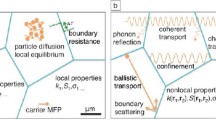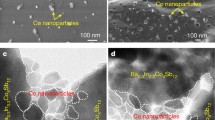Abstract
It is well known that nanoparticles have the ability to enhance the performance of thermoelectric materials. A comprehensive analytical model exploring the mechanism by which this enhancement takes place remains largely absent from the literature. We address this deficiency by introducing a simple model of a nanoparticle as a circular nanoinhomogeneity and analyze its effect on thermal–electric conversion efficiency and the effective properties of thermoelectric composites. Taking interface phonon scattering into consideration, the effective material parameters around a nanoinhomogeneity are derived explicitly, while the effective properties and optimal conversion efficiency are discussed in detail via numerical analysis. Our results show that the nanoinhomogeneity equally effects both the figure of merit and the conversion efficiency. A carefully selected inhomogeneity not only improves the thermoelectric power factor but also suppresses the effective thermal conductivity, and thus greatly improves the optimal conversion efficiency. Specifically, a nanoinhomogeneity with higher electric and thermal conductivities generates a higher thermoelectric figure of merit regardless of the magnitude of its Seebeck coefficient. Noting that the thermoelectric performance improved by the presence of the inhomogeneity is restricted by the intensity of interface phonon scattering, we further calculate the expressions for the effective figure of merit in certain extreme cases. Furthermore, we see that a smaller inhomogeneity has a stronger ability to improve the conversion efficiency for a given doping proportion, mainly because the interface phonon scattering of the smaller inhomogeneity has a relatively greater effect on thermal conduction.






Similar content being viewed by others
References
Bell, L.E.: Cooling, heating, generating power, and recovering waste heat with thermoelectric systems. Science 321, 1457–1461 (2008). https://doi.org/10.1126/science.1158899
Tritt, T.M., Böttner, H., Chen, L.: Thermoelectrics: direct solar thermal energy conversion. MRS Bull. 33, 366–368 (2008). https://doi.org/10.1557/mrs2008.73
Nolas, G.S., Morelli, D.T., Tritt, T.M.: Skutterudites: A phonon-glass-electron crystal approach to advanced thermoelectric energy conversion applications. Annu. Rev. Mater. Sci. 29, 89–116 (1999). https://doi.org/10.1146/annurev.matsci.29.1.89
Hicks, L.D., Dresselhaus, M.S.: Effect of quantum-well structures on the thermoelectric figure of merit. Phys. Rev. B 47, 12727 (1993). https://doi.org/10.1103/PhysRevB.47.12727
Brown, S.R., Kauzlarich, S.M., Gascoin, F., Snyder, G.J.: \(\text{ Yb }_{14}~\text{ MnSb }_{{11}}\): new high efficiency thermoelectric material for power generation. Chem. Mater. 18, 1873–1877 (2006). https://doi.org/10.1021/cm060261t
Venkatasubramanian, R., Siivola, E., Colpitts, T., O’quinn, B.: Thin-film thermoelectric devices with high room-temperature figures of merit. Nature 413, 597–602 (2001). https://doi.org/10.1038/35098012
Polvani, D.A., Meng, J.F., Chandra Shekar, N.V., Sharp, J., Badding, J.V.: Large improvement in thermoelectric properties in pressure-tuned p-type \(\text{ Sb }_{1.5}\text{ Bi }_{0.5}\text{ Te }_{3}\). Chem. Mater. 13, 2068–2071 (2001). https://doi.org/10.1021/cm000888q
Liu, W., Yan, X., Chen, G., Ren, Z.: Recent advances in thermoelectric nanocomposites. Nano Energy 1, 42–56 (2012). https://doi.org/10.1016/j.nanoen.2011.10.001
Cook, B.A., Kramer, M.J., Harringa, J.L., Han, M.K., Chung, D.Y., Kanatzidis, M.G.: Analysis of nanostructuring in high figure-of-merit \(\text{ Ag }_{1-x}\text{ Pb }_{m}\text{ SbTe }_{2+_{m}}\) thermoelectric materials. Adv. Funct. Mater. 19, 1254–1259 (2009). https://doi.org/10.1002/adfm.200801284
Snyder, G.J., Toberer, E.S.: Complex thermoelectric materials. Nat. Mater. 7, 105–114 (2011). https://doi.org/10.1038/nmat2090
Chen, Z.G., Han, G., Yang, L., Cheng, L., Zou, J.: Nanostructured thermoelectric materials: current research and future challenge. Prog. Natl. Sci. Mater. Int. 22, 535–549 (2012). https://doi.org/10.1016/j.pnsc.2012.11.011
Snyder, G.J., Ursell, T.S.: Thermoelectric efficiency and compatibility. Phys. Rev. Lett. 91, 148301 (2003). https://doi.org/10.1103/PhysRevLett.91.148301
Yang, Y., Ma, F.Y., Lei, C.H., Liu, Y.Y., Li, J.Y.: Is thermoelectric conversion efficiency of a composite bounded by its constituents? Appl. Phys. Lett. 102, 053905 (2013). https://doi.org/10.1063/1.4791684
Song, K., Song, H.P., Gao, C.F.: Macro-performance of multilayered thermoelectric medium. Chin. Phys. B 26, 127307 (2017). https://doi.org/10.1088/1674-1056/26/12/127307
Song, K., Song, H.P., Li, M., Schiavone, P., Gao, C.F.: Effective properties of a thermoelectric composite containing an elliptic inhomogeneity. Int. J. Heat Mass Transf. 135, 1319–1326 (2019). https://doi.org/10.1016/j.ijheatmasstransfer.2019.02.088
Swartz, E.T., Pohl, R.O.: Thermal resistance at interfaces. Appl. Phys. Lett. 51, 2200–2202 (1987). https://doi.org/10.1063/1.98939
Callen, H.B.: Thermodynamics: An Introduction to the Physical Theories of Equilibrium Thermostatics and Irreversible Thermodynamics. Wiley, New York (1960)
Yang, Y., Lei, C., Gao, C.F., Li, J.: Asymptotic homogenization of three-dimensional thermoelectric composites. J. Mech. Phys. Solids 76, 98–126 (2015). https://doi.org/10.1016/j.jmps.2014.12.006
Song, K., Song, H.P., Gao, C.F.: Improving compatibility between thermoelectric components through current refraction. Chin. Phys. B 27, 077304 (2018). https://doi.org/10.1088/1674-1056/27/7/077304
Gruverman, A., Wu, D., Lu, H., Wang, Y., Jang, H.W., Folkman, C.M., Zhuravlev, M.Y., Felker, D., Rzchowski, M., Eom, C.B., Tsymbal, E.Y.: Tunneling electroresistance effect in ferroelectric tunnel junctions at the nanoscale. Nano Lett. 9, 3539–3543 (2009). https://doi.org/10.1021/nl901754t
Lehwald, S., Szeftel, J.M., Ibach, H., Rahman, T.S., Mills, D.L.: Surface phonon dispersion of Ni (100) measured by inelastic electron scattering. Phys. Rev. Lett. 50, 518–521 (1983). https://doi.org/10.1103/PhysRevLett.50.518
Meyerhof, W.E.: Contact potential difference in silicon crystal rectifiers. Phys. Rev. 71, 727–735 (1947). https://doi.org/10.1103/PhysRev.71.727
Song, K., Schiavone, P.: Thermal conduction around a circular nanoinhomogeneity. Int. J. Heat Mass Transf. 150, 119297 (2020). https://doi.org/10.1016/j.ijheatmasstransfer.2019.119297
Song, K., Song, H.P., Gao, C.F.: Unavoidable electric current caused by inhomogeneities and its influence on measured material parameters of thermoelectric materials. J. Appl. Phys. 123, 124105 (2018). https://doi.org/10.1063/1.5011778
Yang, Y., Xie, S.H., Ma, F.Y., Li, J.Y.: On the effective thermoelectric properties of layered heterogeneous medium. J. Appl. Phys. 111, 013510 (2012). https://doi.org/10.1063/1.3674279
Harman, T.C., Honig, J.M.: Thermoelectric and Thermomagnetic Effects and Applications. McGraw-Hill, New York (1967)
Sumithra, S., Takas, N.J., Misra, D.K., Nolting, W.M., Poudeu, P.F.P., Stokes, K.L.: Enhancement in thermoelectric figure of merit in nanostructured Bi\(_{2}\)Te\(_{3}\) with semimetal nanoinclusions. Adv. Energy Mater. 1, 1141–1147 (2011). https://doi.org/10.1002/aenm.201100338
Alam, H., Ramakrishna, S.: A review on the enhancement of figure of merit from bulk to nano-thermoelectric materials. Nano Energy 2, 190–212 (2013). https://doi.org/10.1016/j.nanoen.2012.10.005
Acknowledgements
Song appreciates the support of the National Natural Science Foundation of China (Grant No. 11902116). Schiavone thanks the Natural Sciences and Engineering Research Council of Canada for their support through a Discovery Grant (Grant # RGPIN 155112).
Author information
Authors and Affiliations
Corresponding author
Additional information
Publisher's Note
Springer Nature remains neutral with regard to jurisdictional claims in published maps and institutional affiliations.
Rights and permissions
About this article
Cite this article
Song, K., Yin, D. & Schiavone, P. Conversion efficiency and effective properties of particulate-reinforced thermoelectric composites. Z. Angew. Math. Phys. 71, 54 (2020). https://doi.org/10.1007/s00033-020-1275-z
Received:
Revised:
Published:
DOI: https://doi.org/10.1007/s00033-020-1275-z




